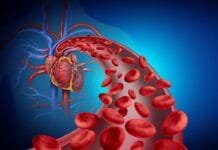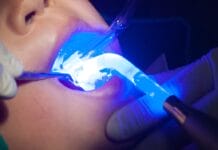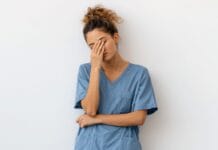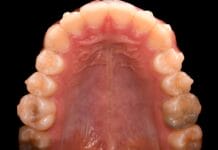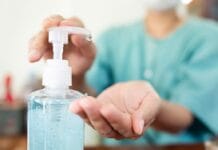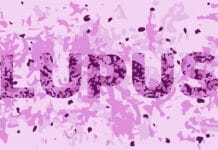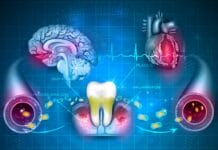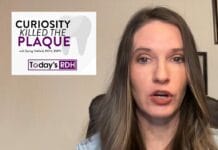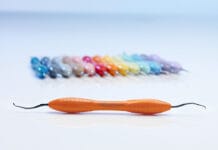Are you in need of CE credits? If so, check out our peer-reviewed, self-study CE courses here.
Test Your Bruxism Knowledge
1. Which of the following is not typically considered a sign or symptom of bruxism?
Bruxism is defined as a repetitive activity in the masticatory muscles characterized by clenching or grinding of the teeth and/or stiffening or thrusting of the mandible, causing forceful contact between the biting surfaces of maxillary and mandibular teeth.1
Signs and symptoms of bruxism can include:1,2
- Linea alba
- Scalloped tongue
- Exostosis
- Tooth wear
- Tooth hypersensitivity
- Fractured teeth and restorations
- Dental implant failure
- Masticatory muscle hypertrophy (especially of the masseter)
- Temporomandibular joint pain, stiffness, and crepitus
- Restricted mouth opening
- Preauricular pain
- Headaches due to temporalis muscle tightness and tenderness
- Unpleasant loud noises during sleep that cause sleep disturbances
References
1. Matusz, K., Maciejewska-Szaniec, Z., Gredes, T., et al. Common Therapeutic Approaches in Sleep and Awake Bruxism - An Overview. Neurol Neurochir Pol. 2022; 56(6): 455-463. https://journals.viamedica.pl/neurologia_neurochirurgia_polska/article/view/90495
2. Lal, S.J., Sankari, A., Weber, K.K. (2024, May 1). Bruxism Management. StatPearls. https://www.ncbi.nlm.nih.gov/books/NBK482466/
2. Sleep bruxism is most common in adults.
Sleep (nocturnal) bruxism is most common in children, with a prevalence of approximately 15% to 40%. The prevalence of sleep bruxism in the adult population ranges from 8% to 10%. Awake (diurnal) bruxism affects between 22% and 31% of the population.1
Reference
1. Lal, S.J., Sankari, A., Weber, K.K. (2024, May 1). Bruxism Management. StatPearls. https://www.ncbi.nlm.nih.gov/books/NBK482466/
3. Sleep bruxism is believed to be regulated by the central nervous system and related to microarousals during sleep. Awake bruxism is often associated with stress and heightened alertness, which can result in increased autonomic cardiac activity.
Sleep bruxism is believed to be regulated by the central nervous system and related to microarousals during sleep. It is associated with arousal and alertness during different phases of the circadian sleep cycle, which occur eight to 14 times a night.1
Directly before episodes of arousal and alertness, individuals with sleep bruxism demonstrate rapid and frequent electrical brain waves in the cortical region. Additionally, they experience increased heart rate, jaw and oropharyngeal muscle tension, respiratory effort, and nasal airflow.1 Masticatory muscle activity during sleep bruxism is characterized as rhythmic (phasic) or non-rhythmic (tonic).2
Awake bruxism is often associated with stress and heightened alertness, which can result in increased autonomic cardiac activity.1 Masticatory muscle activity during awake bruxism is characterized as repetitive or sustained tooth contact and/or by bracing or thrusting of the mandible.2
References
1. Lal, S.J., Sankari, A., Weber, K.K. (2024, May 1). Bruxism Management. StatPearls. https://www.ncbi.nlm.nih.gov/books/NBK482466/
2. de Baat, C., Verhoeff, M.C., Ahlberg, J., et al. Medications and Addictive Substances Potentially Inducing or Attenuating Sleep Bruxism and/or Awake Bruxism. J Oral Rehabil. 2021; 48(3): 343-354. https://pmc.ncbi.nlm.nih.gov/articles/PMC7984358/
4. Which of the following is a risk factor for bruxism?
Considered multifactorial, bruxism is associated with several risk factors, such as:1
- Obstructive sleep apnea
- Sleep disorders
- Medication use
- Neurologic and psychiatric disorders
- Genetic predisposition
Reference
1. Lal, S.J., Sankari, A., Weber, K.K. (2024, May 1). Bruxism Management. StatPearls. https://www.ncbi.nlm.nih.gov/books/NBK482466/
5. Which medication potentially induces or aggravates bruxism?
Several medications and addictive substances can potentially induce or aggravate bruxism. While others may reduce bruxism.1
Medications that potentially induce or aggravate bruxism include:1
- Selective serotonin reuptake inhibitors such as fluoxetine (Prozac) and sertraline (Zoloft)
- Anticonvulsants such as phenytoin (Dilantin)
- Phenethylamines such as amphetamines to treat attention deficit hyperactivity disorder
Though more scientific evidence for the association between fluoxetine and other SSRIs with bruxism is needed, there is a proposed theory. An excess of serotonin in the nerve synapses is suspected to lead to an inhibitory effect on the release of dopamine, which plays a significant role in movement control.1
Addictive substances that can potentially induce or aggravate bruxism include:1
- Alcohol
- Nicotine
- Methamphetamine
- Heroin
- Methylenedioxymethamphetamine (MDMA)
- Piperazines
Medications that potentially reduce bruxism include:1
- Gabapentin
- Buspirone
- Botulinum toxin A
- Hydroxyzine
Reference
1. de Baat, C., Verhoeff, M.C., Ahlberg, J., et al. Medications and Addictive Substances Potentially Inducing or Attenuating Sleep Bruxism and/or Awake Bruxism. J Oral Rehabil. 2021; 48(3): 343-354. https://pmc.ncbi.nlm.nih.gov/articles/PMC7984358/
6. Which condition is associated with bruxism?
Multiple neurological and psychological conditions are associated with bruxism, such as:1
- Alzheimer’s disease
- Huntington’s disease
- Multiple system atrophy
- Down syndrome
- Rett syndrome
- Cerebral palsy
- Traumatic brain injury
- Attention deficit hyperactivity disorder
- Anxiety
Reference
1. Lal, S.J., Sankari, A., Weber, K.K. (2024, May 1). Bruxism Management. StatPearls. https://www.ncbi.nlm.nih.gov/books/NBK482466/


